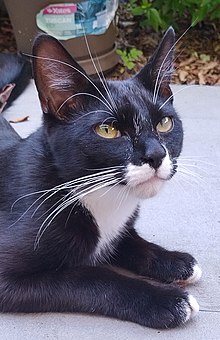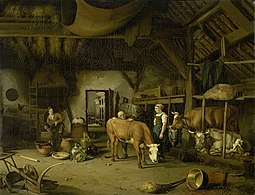Pet



A pet, or companion animal, is an
Two of the most popular pets are
Pets provide their owners, or guardians,
People most commonly get pets for companionship, to protect a home or property, or because of the perceived beauty or attractiveness of the animals.
Pet popularity
In China, spending on domestic animals has grown from an estimated $3.12 billion in 2010 to $25 billion in 2018. The Chinese people own 51 million dogs and 41 million cats, with pet owners often preferring to source pet food internationally.[4] There are a total of 755 million pets, increased from 389 million in 2013.[5]
According to a survey promoted by Italian family associations in 2009, it is estimated that there are approximately 45 million pets in Italy. This includes 7 million dogs, 7.5 million cats, 16 million fish, 12 million birds, and 10 million snakes.[6]
A 2007 survey by the University of Bristol found that 26% of UK households owned cats and 31% owned dogs, estimating total domestic populations of approximately 10.3 million cats and 10.5 million dogs in 2006.[7] The survey also found that 47.2% of households with a cat had at least one person educated to degree level, compared with 38.4% of homes with dogs.[8]
Sixty-eight percent of U.S. households, or about 85 million families, own a pet, according to the 2017-2018 National Pet Owners Survey conducted by the American Pet Products Association (APPA). This is up from 56 percent of U.S. households in 1988, the first year the survey was conducted.
Most popular pets in the U.S. (millions)[14][15] Pet Global population U.S. population U.S. inhabited households U.S. average per inhabited household Cat 202 93.6 38.2 2.45 Dog 171 77.5 45.6 1.70 Fish N/A 171.7 13.3 12.86 Small mammals N/A 15.9 5.3 3.00 Birds N/A 15.0 6.0 2.50 Reptiles & amphibians N/A 13.6 4.7 2.89 Equine N/A 13.3 3.9 3.41
Effects on pets' health
Keeping animals as pets may be detrimental to their health if certain requirements are not met. An important issue is inappropriate feeding, which may produce clinical effects. The consumption of
Housepets, particularly dogs and cats in industrialized societies, are highly susceptible to obesity. Overweight pets have been shown to be at a higher risk of developing diabetes, liver problems, joint pain, kidney failure, and cancer. Lack of exercise and high-caloric diets are considered to be the primary contributors to pet obesity.[21][22][23]
Effects of pets on their caregivers' health


Health benefits
It is widely believed among the public, and among many scientists, that pets probably bring mental and physical health benefits to their owners;
Observed correlations
Pets might have the ability to stimulate their caregivers, in particular the elderly, giving people someone to take care of, someone to exercise with, and someone to help them heal from a physically or psychologically troubled past.
Pets in long-term care institutions
People residing in a long-term care facility, such as a hospice or nursing home, may experience health benefits from pets. Pets help them to cope with the emotional issues related to their illness. They also offer physical contact with another living creature, something that is often missing in an elder's life.[10][42] Pets for nursing homes are chosen based on the size of the pet, the amount of care that the breed needs, and the population and size of the care institution.[29] Appropriate pets go through a screening process and, if it is a dog, additional training programs to become a therapy dog.[43] There are three types of therapy dogs: facility therapy dogs, animal-assisted therapy dogs, and therapeutic visitation dogs. The most common therapy dogs are therapeutic visitation dogs. These dogs are household pets whose handlers take time to visit hospitals, nursing homes, detention facilities, and rehabilitation facilities.[28] Different pets require varying amounts of attention and care; for example, cats may have lower maintenance requirements than dogs.[44]
Connection with community
In addition to providing health benefits for their owners, pets also impact the social lives of their owners and their connection to their community. There is some evidence that pets can facilitate social interaction.
Health risks
Health risks that are associated with pets include:
- Aggravation of allergies and asthma caused by dander and fur or feathers
- Falling injuries. Tripping over pets, especially dogs causes more than 86,000 falls serious enough to prompt a trip to the emergency room each year in the United States.[47] Among elderly and disabled people, these falls have resulted in life-threatening injuries and broken bones.
- Injury, mauling, and sometimes death caused by pet bites and attacks
- Disease or parasites due to animal hygiene problems, lack of appropriate treatment, and undisciplined behavior (feces and urine)
- Stress caused by the behavior of animals
- Anxiety over who will care for the animal should the owner no longer be able to do so
Legislation
Treaties

| | Signed and ratified | | Acceded or succeeded |
| | Only signed | | Not signed (CoE member states) |
| | Not signed (non-CoE member states) |
The European Convention for the Protection of Pet Animals is a 1987 treaty of the Council of Europe – but accession to the treaty is open to all states in the world – to promote the welfare of pet animals and ensure minimum standards for their treatment and protection. It went into effect on 1 May 1992, and as of June 2020, it has been ratified by 24 states.[48]
National and local laws
Ownership or guardianship
Pets have commonly been considered
Limitations on species
States, cities, and towns in
In
Killing and eating pets
In January 2011, the Belgian Federal Agency for the Safety of the Food Chain stated that people are not allowed to kill random cats walking in their garden, but "nowhere in the law does it say that you can't eat your cat, dog, rabbit, fish or whatever. You just have to kill them in an animal-friendly way."[60] Since 1 July 2014, it is illegal in the Netherlands for owners to kill their own cats and dogs kept as pets. Parakeets, guinea pigs, hamsters and other animals may still be killed by their owners, but nonetheless when owners mistreat their companion animals (for example, in the process of killing them), the owners can still be prosecuted under Dutch law.[61]
Environmental impact
This section relies largely or entirely upon a single source. (May 2021) ) |
Pets have a considerable environmental impact, especially in countries where they are common or held in high densities. For instance, the 163 million dogs and cats kept in the United States consume about 20% of the amount of dietary energy that humans do and an estimated 33% of the animal-derived energy.
Types
While many people have kept many different species of animals in captivity over the course of human history, only a relative few have been kept long enough to be considered domesticated. Other types of animal, notably monkeys, have never been domesticated but are still sold and kept as pets. Some wild animals are kept as pets, such as tigers, even though this is illegal. There is a market for illegal pets.
Domesticated
Large
.Fish kept as pets include: goldfish, koi, Siamese fighting fish (Betta), barb, guppy, molly, Japanese rice fish (Medaka), and oscar.
. .Wild animals

Wild animals are kept as pets. The term wild in this context specifically applies to any species of animal which has not undergone a fundamental change in behavior to facilitate a close co-existence with humans. Some species may have been bred in captivity for a considerable length of time, but are still not recognized as
Generally, wild animals are recognized as not suitable to keep as pets, and this practice is completely banned in many places. In other areas, certain species are allowed to be kept, and it is usually required for the owner to obtain a permit. It is considered
History
Prehistory
Archaeology suggests that human ownership of dogs as pets may date back to at least 12,000 years ago.[65]
Ancient history
Victorian era: the rise of modern pet keeping
Throughout the 17th and 18th-century pet keeping in the modern sense gradually became accepted throughout
Economy
As the popularity of pet-keeping in the modern sense rose during the Victorian era, animals became a fixture within urban culture as commodities and decorative objects.[70] Pet keeping generated a commercial opportunity for entrepreneurs. By the mid-19th century, nearly twenty thousand street vendors in London dealt with live animals.[71] The popularity of animals also developed a demand for animal goods such as accessories and guides for pet keeping. Pet care developed into a big business by the end of the nineteenth century.[72]
Profiteers also sought out pet stealing as a means for economic gain. Utilizing the affection that owners had for their pets, professional dog stealers would capture animals and hold them for ransom.[73] The development of dog stealing reflects the increased value of pets. Pets gradually became defined as the property of their owners. Laws were created that punished offenders for their burglary.[74]
Social
Pets and animals also had social and cultural implications throughout the nineteenth century. The categorization of dogs by their breeds reflected the hierarchical, social order of the Victorian era. The
Entertainment
The popularity of dog and pet keeping generated
Pet ownership by non-humans
Pet ownership by animals in the wild, as an analogue to the human phenomenon, has not been observed and is likely non-existent in nature.
A 2010 study states that human relationships with animals have an exclusive human cognitive component and that pet-keeping is a fundamental and ancient attribute of the human species.
It is debated whether this redirection of human nurturing behaviour towards non-human animals, in the form of pet-keeping, was
Animals in
Pets in art
-
Katharine of Aragon with a monkey
-
The Girl with the Marmot by Jean-Honoré Fragonard
-
- Young Lady with parrot by Édouard Manet 1866
-
Antoinette Metayer (1732–88) and her pet dog
-
The Lady with an Ermine
-
Sir Henry Raeburn- Boy and Rabbit
-
Eos, A Favorite Greyhound of Prince Albert
-
A Neapolitan Woman
-
Signal, a Grey Arab, with a Groom in the Desert
-
Eduardo Leon Garrido. An Elegant Lady with her Dog
-
The Fireplace depicting a Pug, James Tissot
-
Rosa Bonheur - Portrait ofWilliam F. Cody
-
Hunt
-
The Pasha's Favourite Tiger, oil painting by Rudolph Ernst
See also
- Alternative pets:
- Digital pet
- Robotic pet
- Animal captivity
- Animal hoarding
- Anthrozoology
- Classroom pet
- Feline arterial thromboembolism
- List of individual cats
- List of individual dogs
- Pet adoption
- Pet loss
- Zoonosis
References
- ^ "Position Statement on Ownership/Guardianship". ASPCA. Retrieved 7 November 2021.
- ^ PMID 8076276.
- ^ McRobbie, Linda Rodriguez (1 August 2017). "Should we stop keeping pets? Why more and more ethicists say yes". The Guardian. Retrieved 3 August 2017.
- ^ Tang, Ailin; Bradsher, Keith (22 October 2018). "The Trade War's Latest Casualties: China's Coddled Cats and Dogs". The New York Times. Retrieved 23 October 2018.
- ^ "China Pet population and ownership 2019 update". China Pet Market. 25 December 2018. Archived from the original on 25 August 2019. Retrieved 25 August 2019.
- ^ "Main_Page45 milioni gli animali domestici in Italia: 150.000 ogni anno vengono abbandonati". Il Messaggero. 22 September 2009. Archived from the original on 11 July 2013.
- ^ "UK domestic cat and dog population larger than thought". University of Bristol. 6 February 2010.
- ^ "More cat owners 'have degrees' than dog-lovers". BBC News. 6 February 2010.
- ^ "Facts + Statistics: Pet statistics | III". iii.org. Retrieved 25 August 2019.
- ^ a b "Animals in Healthcare Facilities: Recommendations to Minimize Potential Risks" (PDF). shea-online.org. Archived from the original (PDF) on 4 March 2016.
- ^ The Humane Society of the United States. "U.S. Pet Ownership Statistics". Retrieved 27 April 2012.
- ^ "U.S. Pet Ownership & Demographics Sourcebook (2012)". Archived from the original on 17 February 2017. Retrieved 16 January 2017.
- ^ Daniel Halper (1 February 2013). "Animal Planet: Pets Outnumber Children 4 to 1 in America". The Weekly Standard. Archived from the original on 4 September 2015. Retrieved 9 February 2013.
- ^ Susan Hayes. "What are the most popular pets around the world?". PetQuestions.com. Archived from the original on 22 October 2010. Retrieved 4 March 2011.
- ^ "Industry Statistics & Trends". American Pet Product Association. Archived from the original on 9 March 2021. Retrieved 4 March 2011.
- ^ "Plants and Your Cat". Cat Fanciers' Association. Archived from the original on 27 December 2009. Retrieved 15 May 2007.
- PMID 12680447.
- ^ "These plants can be poisonous to dogs". Sunset Magazine. 12 July 2010. Retrieved 17 October 2013.
- ^ Klein, Jerry (10 December 2018). "Are Poinsettias Poisonous to Dogs?". American Kennel Club. Retrieved 26 August 2019.
- ^ Neff, David (19 June 2023). "What Human Foods Can Birds Eat?". BirdBonica. Retrieved 30 June 2023.
- ^ "Overweight Dogs". Pet Care. The American Society for the Prevention of Cruelty to Animals (ASPCA). Retrieved 17 October 2013.
- ^ "Overweight Cats". Pet Care. The American Society for the Prevention of Cruelty to Animals (ASPCA). Retrieved 17 October 2013.
- Huffington Post. Retrieved 17 October 2013.
- ^ a b "Pets are a kid's best friend, right? Maybe not, study says". The Philadelphia Inquirer. Retrieved 27 December 2017.
- ^ a b c d "The Health Benefits of Pets". US Government National Institute of Health. Archived from the original on 5 May 2012. Retrieved 25 December 2006.
- ^ "Pets Are Good For Us—But Not in the Ways We Think They Are". National Geographic. 25 November 2017. Archived from the original on 25 November 2017. Retrieved 27 December 2017.
- ^ RAND. Retrieved 27 December 2017.
- ^ a b Reiman, Steve. "Therapy Dogs in the Long-Term Health Care Environment" (PDF). Archived from the original (PDF) on 6 May 2012. Retrieved 27 April 2012.
- ^ a b c Whiteley, Ellen H. (1986). "The Healing Power of Pets". The Saturday Evening Post. Vol. 258, no. 7. pp. 2–102. Retrieved 5 November 2006. Academic Search Elite. EBSCOhost. Polk Library, UW Oshkosh
- PMID 26963923.
- ^ Asp, Karen (2005). "Volunteer Pets". Prevention. 57 (4): 176–78. Retrieved 5 November 2006. Academic Search Elite. EBSCOhost. Polk Library, UW Oshkosh
- PMID 11641292.
- S2CID 40206732.
- S2CID 2188860.
- PMID 17205113.
- S2CID 25544682.
- ^ Dembicki, D and Anderson, J. 1996. Journal of Nutrition in Gerontology and Geriatrics. Volume 15 Issue 3, pages 15-31.
- ^ Jodee (8 July 2010). "Want to Reduce Risk of Heart Disease? Get a Pet". Archived from the original on 27 March 2013. Retrieved 27 April 2012.
- ^ Friedmann E, Galik E, Thomas SA, Hall PS, Chung SY, McCune S. Evaluation of a Pet-Assisted Living Intervention for improving functional status in assisted living residents with mild to moderate cognitive impairment. American Journal of Alzheimer's Disease and Other Dementias.2015:30(3):276-289
- ^
Parslow, Ruth; Jorm, Anthony; Christensen, Helen; Rodgers, Bryan; Jacomb, Patricia (January–February 2005). "Pet Ownership and Health in Older Adults". Gerontology. 40. 51 (1): 40–47. S2CID 21851049.
- ^ Farlex. "The Free Dictionary By Farlex". Retrieved 27 April 2012.
- ^ Reinman, Steve. "Therapy Dogs in the Long-Term Health Care Environment" (PDF). Archived from the original (PDF) on 6 May 2012. Retrieved 27 April 2012.
- ^ Huculak, Chad (4 October 2006). "Super Furry Animals". Edmonton: W7.. LexisNexis. Polk Library, UW Oshkosh. 5 November 2006.
- ^ Bruck, Laura (1996). "Today's Ancillaries, Part 2: Art, music and pet therapy". Nursing Homes: Long-Term Care Management. 45 (7): 36. Retrieved 5 November 2006. Academic Search Elite. EBSCOhost. Polk Library, UW Oshkosh.
- ^ Wood L, Martin K, Christian H, Nathan A, Lauritsen C, Houghton S, Kawachi I, McCune S. The pet factor – Companion animals as a conduit for getting to know people, friendship formation, and social support. PLoS One. 2015:10(4):e0122085
- ^ Irvine, Leslie (2013). My Dog Always Eats First: Homeless People and Their Animals. Boulder, CO: Lynne Rienner Publishers, Inc.
- ^ "In the Home, a Four-Legged Tripwire". The New York Times. 27 March 2009.
- ^ "Chart of signatures and ratifications of Treaty 125. European Convention for the Protection of Pet Animals". Council of Europe. Retrieved 4 June 2020.
- ^ Garner, Robert. "A Defense of a Broad Animal Protectionism," in Francione and Garner 2010, pp. 120–121.
- ISBN 978-1-56639-461-1.
- ^ Francione, Gary. Animals, Property, and the Law. Temple University Press, 1995.
- Francione, Gary. Animals, Property, and the Law. Temple University Press, 1995; this paperback edition 2007.
- ^ "Do You Live in a Guardian Community?". The Guardian Campaign. Archived from the original on 4 October 2013. Retrieved 1 September 2013.
- ^ Nolen, R. Scott (1 March 2005). "Now, it's the lawyers' turn". Journal of the American Veterinary Medical Association. Retrieved 29 August 2013.
- ^ Chapman, Tamara (March–April 2005). "Owner or Guardian?" (PDF). Trends Magazine. Retrieved 29 August 2013.
- ^ Katz, Jon (5 March 2004). "Guarding the Guard Dogs?". Home / Heavy Petting: Pets & People. Slate. Retrieved 29 August 2013.
- ^ Sharon Dijksma (28 January 2015). "Kamerbrief invoering huisdierenlijst zoogdiersoorten". Rijksoverheid.nl (in Dutch). Dutch Government. Archived from the original on 6 August 2020. Retrieved 18 May 2020.
- ^ "Een rendier mag dan weer wel". Trouw (in Dutch). 3 December 2013. Retrieved 18 May 2020.
- ^ Rijksoverheid / ANP (31 January 2017). "Lijst 2017 bekend: welke dieren mag jij als huisdier houden?" (in Dutch). BNNVARA. Retrieved 19 May 2020.
- ^ jrosquin (5 January 2011). "Uw kat opeten is wettelijk toegestaan". Gazet van Antwerpen (in Dutch). Retrieved 4 June 2021.
- ^ "Zelf doden huisdieren vanaf vandaag verboden". RTL Nieuws (in Dutch). 1 July 2014. Retrieved 4 June 2021.
- ^ "Dog, Cat Feces Linked To Climate Change: UCLA Study - CBS Los Angeles". www.cbsnews.com. 3 August 2017. Retrieved 9 April 2024.
- ^ PMID 28767700.
- ^ Farlex. "The Free Dictionary by Farlex". Retrieved 27 April 2012.
- ^
Clutton-Brock, Juliet (1995). "Origins of the dog: domestication and early history". In Serpell, James (ed.). The domestic dog: its evolution, behaviour and interactions with people. Cambridge: Cambridge University Press. pp. 10–11. ISBN 978-0-521-42537-7.
- ^ Messenger, Stephen (13 June 2014). "9 Touching Epitaphs Ancient Greeks And Romans Wrote For Their Deceased Dogs". The Dodo. Retrieved 18 January 2019.
- ISBN 978-0-521-01771-8.
- ^ Mertz, Barbara (1978). Red Land, Black Land: Daily Life in Ancient Egypt. Dodd Mead.
- ^ Amato, Sarah (2015). Beastly Possession: Animals in the Victorian Consumer Culture. Toronto: University of Toronto Press. p. 25.
- ^ Amato, Sarah (2015). Beastly Possessions: Animals in Victorian Consumer Culture. University of Toronto Press. p. 6.
- ^ Ritvo, Harriet (1987). The Animal Estate: The English and Other Creatures in the Victorian Age. Cambridge: Harvard University Press. p. 86.
- ^ Amato, Sarah (2015). Beastly Possession: Animals in Victorian Consumer Culture. Toronto: University of Toronto Press. p. 48.
- ^ Philo, Chris (1989). Animal Space, Beastly Places: New Geographies of Human-Animal Relations. Routledge. pp. 38–389.
- ^ Philo, Chris (1989). Animal Space, Beastly Places: New Geographies of Human-Animal Relations. Routledge. p. 41.
- ^ Amato, Sarah (2015). Beastly Possession: Animals in Victorian Consumer Culture. Toronto: University of Toronto Press. p. 55.
- ^ Amato, Sarah (2015). Beastly Possession: Animals in Victorian Consumer Culture. Toronto: University of Toronto Press. p. 10.
- ^ Ritvo, Harriet (1987). The Animal Estate: The English and Other Creatures in the Victorian Era. Cambridge: Harvard University Press. p. 104.
- ^ Ritvo, Harriet (1987). The Animal Estate: The English and Other Creatures in Victorian Age. Cambridge: Harvard University Press. pp. 7–8.
- ^ Ritvo, Harriet (1987). The Animal Estate: The English and Other Creatures in the Victorian Age. Cambridge: Harvard University Press. p. 98.
- ^ Ritvo, Harriet (1987). The Animal Estate: The English and Other Creatures in the Victorian Age. Cambridge: Harvard University Press. p. 66.
- ^ Ritvo, Harriet (1987). The Animal Estate: The English and Other Creatures in the Victorian Age. Cambridge: Harvard University Press. p. 104.
- ^ S2CID 55412536. Archived from the original(PDF) on 3 March 2019. Retrieved 3 September 2019.
- ^ a b Herzog, Hal (18 June 2010). "Are Humans the Only Animals That Keep Pets?". Psychology Today. Retrieved 4 February 2023.
- ISBN 978-1-317-59838-1.
- ^ ISBN 978-0-19-539669-0.
- S2CID 144313567.
Further reading
- David Grimm (2015). Citizen Canine: Our Evolving Relationship with Cats and Dogs. PublicAffairs. ISBN 978-1-61039-550-2.
External links
- Companion Animal Demographics in the United States: A Historical Perspective from The State of the Animals II: 2003
 Quotations related to Pet at Wikiquote
Quotations related to Pet at Wikiquote























